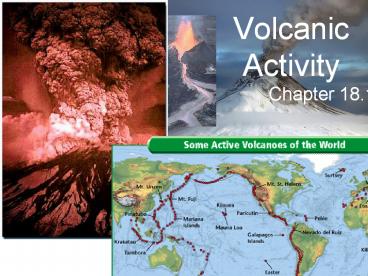Volcanic Activity - PowerPoint PPT Presentation
1 / 16
Title:
Volcanic Activity
Description:
Volcanic Activity Chapter 18.1 Magma Magma is a mixture of molten rock, minerals and gasses. Magma forms when rock melts at 800 C to 1200 C Molten Core with Magma ... – PowerPoint PPT presentation
Number of Views:156
Avg rating:3.0/5.0
Title: Volcanic Activity
1
Volcanic Activity
- Chapter 18.1
2
(No Transcript)
3
Magma
- Magma is a mixture of molten rock, minerals and
gasses. - Magma forms when rock melts at 800C to 1200C
4
Molten Core with Magma plumes
5
What determines when rock will melt?
- Pressure- Rocks under pressure melt slower.
- Water- Wet rocks will melt at lower temperatures.
6
Viscosity
- The thickness of a liquid.
- Magmas and lavas high in silica have higher
viscosities than magmas and lavas low in silica. - Hot lavas have more dissolved silicas and are
therefore more viscous.
7
Three Types of Magma
- Basaltic
- Andesitic
- Rhyolitic
8
Basaltic Magma
- Upper mantle rocks melt 50 silica
- Rises rapidly to surface
- Low viscosity
- Low amounts of gasses and silica
- Slow Eruption
9
Andesitic Magma
- 60 silica
- Intermediate viscosity
- Intermediate eruptions
10
Rhyolitc Magma
- 70 silica
- High Viscosity
- Large volumes of gas trapped
- Explosive eruptions
11
(No Transcript)
12
(No Transcript)
13
(No Transcript)
14
Section Assessment
- 1. Match the magma types with their
characteristics. - ___ basaltic
- ___ andesitic
- ___ rhyolitic
B A C
A. intermediate viscosity content, forms from
oceanic crust and oceanic sediments B. low
viscosity and gas content, forms from rocks in
the upper mantle C. high viscosity, forms from
continental crust materials
15
Section Assessment
- 2. What would be the likely effect if the volcano
at Yellowstone National Park were to erupt? Why?
It would most likely be a devastating eruption
because it would be fueled by rhyolitic magma,
which has a very high viscosity and gas content.
16
Section Assessment
- 3. Identify whether the following statements are
true or false.
true true false true
______ It is unlikely that Mount Kilauea in
Hawaii will explosively erupt. ______ Wet
granite will melt at a lower temperature than dry
granite. ______ A liquid with a high viscosity
will also have a high flow rate. ______ Major
eruptions of Mount St. Helens in Washington state
and Mount Fuji in Japan would probably be
similar in nature.































